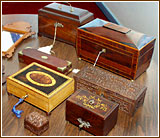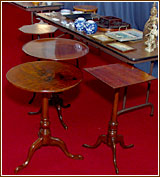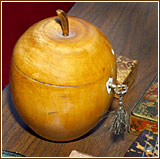FABULOUS FINDS AND OUTRAGEOUS FAKES
Behind The Scenes With Antiques Detective Richard Pillatt

By Hoag Levins ...| ...July 6, 2003

CAMDEN, N.J. -- Richard Pillatt, president of the Camden County Historical Society and antique furniture authority, has three words for those who dream of stumbling across a cheap antique that may

|
| Photo: Hoag Levins |
Camden County Historical Society president Richard Pillatt is an 18th-century furniture authority and Chinese porcelain collector. Behind him are some of the artifacts used in the presentation.
| later prove to be worth a fortune: proceed with caution.
Pillatt, who has been a professional restorer of 18th- and 19th-century furniture for 33 years, is himself an avid collector and knows the antique business from both sides of the counter. In a weekend seminar at the Historical Society, Pillatt took the stage as 'The Antiques Detective' to help the audience understand how the buying and selling of antiques is far more complicated -- and fraught with fraud -- than it may appear.
Fabulous finds
To demonstrate how the line between fabulous finds and outrageous fakes can be as narrow as it is subtle, he accompanied his talk with an extensive display of comparison objects ranging from Chinese porcelains and Victorian snuff boxes to miniature landscapes and wooden tea tables. Each group contained genuine antiques of high value as well as fakes that looked genuine. As part of the hands-on presentation, he dared the audience to tell them apart.
"The complexities of authenticating antiques just naturally leaves a great deal of room for unscrupulous activities," he warned. "This is even more so as 'The Antiques Roadshow' has become one of the most popular TV shows in history, driving large numbers of people to dream about finding a pot of gold at the local flea market or antique gallery."
Collingswood shop
Pillatt, whose Collingswood shop repairs and restores 18th- and 19th-century furniture for museums and collectors, explained, "The amount of fraud in the antiques business is getting worse. To a large degree this is because of the

|
| Photo: Hoag Levins |
Boxes, mirrors and other small items are among the most frequently faked antiques.
| dwindling supply of authentic period items. What many people don't recognize is that antiques are a nonrenewable resource. There is only a certain, finite number of real things like, say, 18th-century mirrors. Every time a house burns down or a flood devastates a community, we lose more antique mirrors; every time a home occupant heaves what looks to him like an old, useless mirror into the trash, the limited resource of furniture pieces from centuries ago is further depleted."
"This," Pillatt continued, "is happening every day at a time when more people than ever appreciate antiques and want 18th-century mirrors. So there is a great financial incentive for the unscrupulous to make fake 18th-century mirrors."
Nor is the problem simple to detect. Many antiques have suffered the ravages of time and wear and must be repaired before they are used or sold. But how much replacement material is allowed before the repaired item ceases to be an authentic antique and is, instead, a modern reproduction containing only a few original parts?
Cloned chair
"It gets even trickier," Pillatt, said. "It is not uncommon for a less-than-honest dealer to have one wonderfully intact 18th-century chair of a highly-desirable kind. But single chairs from any period don't sell nearly as well as multiples. So, the dealer

|
| Photo: Hoag Levins |
Modern porcelain can be almost identical to Chinese porcelains produced centuries ago.
| will go to a cabinetmaker, have the chair pulled completely to pieces and then have two chairs made out of those pieces, so that some parts are original on both chairs and some parts are clever reproductions. Even when a person with a practiced eye looks, he or she will see the antique wood and tend to assume both chairs are an antique set. This kind of nasty thing is, unfortunately, common and we're talking here about transactions often involving tens of thousands of dollars."
"The acceptable threshold for modern replacement parts in a restored authentic antique is normally set at 10%," he said. "This rule is tightly enforced by the most respected dealers and the major shows, such as the annual Philadelphia Antique Show which vets the items dealers display. The show has a group of experts who go through the collections. They may look at a chest of drawers that is labeled 'George III, English,' and note that it has a new leg cap or one new handle. But because that falls below the 10% threshold, it's acceptable. But if it has a new set of legs, it would be rejected from the show."
Antique fakes
Then, Pillatt said, there are furniture pieces that were created as reproductions or fakes of real antiques, but are now so old that they are themselves antiques.
"It gets really blurry when you burrow down into all this," he explained. "For instance, Chippendale was made in the 18th century. But when the Centennial was held in

|
| Photo: Hoag Levins |
18th-century snake-footed tea tables are highly prized. But which are real and which are cleverly-crafted reproductions?
|
Philadelphia in 1876, the American public fell madly in love with the 18th-century pieces they saw there. This sparked a high demand on the furniture market to make reproductions. As a result, tremendous amounts of 18th-century-style Chippendale furniture was made in the late 19th century. Some of these are easy to identify because they include Victorian design elements. But some of these were made exactly like the 18th-century pieces and now they are more than 120 years old and you can't tell the difference."
Meanwhile, less-than-honest dealers can acquire the Victorian reproductions, have them reworked to remove all Victorian details, then put them on sale as 18th-century items. "The value difference is very substantial," he said.
Fooling the experts
"Identifying the real antiques can be incredibly difficult and the 'experts' can be fooled," he said. "The dealers can be fooled. The museums can be fooled. Behind the scenes, museums are always shuffling around objects that one year they thought were real, but then, suddenly, the next year, they took down as fakes. Then, the third year, they'll do x-rays that confirm the object is real again."
"I have been snookered," Pillatt readily admitted as he held aloft a tea caddy shaped like a large wooden apple. "I always wanted an apple tea caddy. I paid $300 for this years ago. If it was 18th century, it would be worth between $1,500 and $2,000 now. It is not. It's a 19th century wooden apple pretending to be an 18th-century wooden apple. To turn it into what appears to be a period tea caddy, a 20th-century craftsman put in a

|
| Photo: Hoag Levins |
Snookered: Purchased as an 18th-century tea caddy, this wooden apple isn't as authentic as it looks.
| 20th-century hinge, a 20th-century lock and actually lined the interior with aluminum foil -- an authentic one would have been lined with lead foil. I didn't discover these things until afterward, but I still love the piece."
Is there any rule of thumb a novice can use while browsing through antique shops and flea markets?
"That is a very common question I get asked each time I do one of these presentations," said Pillatt, "and I wish I could offer a simple answer. But I can't. There are too many variables and the whole thing is just too complicated. I think one of the things 'The Antiques Roadshow' doesn't do well is show how its experts transport a large reference library around with them. They don't make snap appraisals and often conduct really extensive research before they come up with the answers you actually see on the show."
A knowledge business
"The point is, the antiques business is a knowledge business, and the kind of knowledge involved doesn't come quickly or easily. You can't find a single book or resource that can guide you," he said.
"If you are determined to purchase authentic antiques but just starting out, find a reputable dealer who can find the kinds of things you're interested in."
"At the same time, remember that the very idea of antique objects touches us in a number of deep, emotional ways that can't always be separated out of the process of evaluating, buying and selling," he said. "I tell people to follow the same practice I follow when I'm buying an object for my home. Buy only what you love. Buy only what reaches out and touches something inside you. Buy only that which you want to live with for a long time."
|



